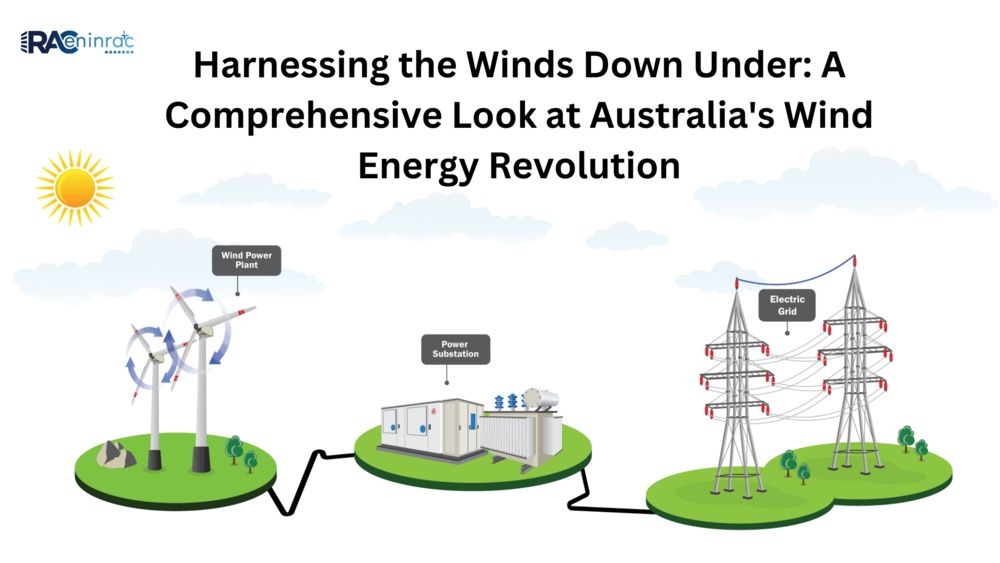Introduction
Australia, known for its vast landscapes and diverse ecosystems, is making significant strides towards a sustainable future by tapping into the power of the winds. In recent years, wind energy has emerged as a prominent player in the nation’s renewable energy landscape. This blog aims to delve into the intricate details of Australia’s wind energy sector, exploring its growth, challenges, and the pivotal role it plays in shaping the country’s clean energy future.
The Rise of Wind Energy in Australia
Australia’s journey into wind energy began in earnest during the early 2000s, when the first wind farms were established. Since then, the sector has experienced exponential growth, contributing substantially to the nation’s renewable energy capacity. With an abundance of suitable locations for wind farms, particularly in regions like South Australia, Victoria, and New South Wales, Australia has harnessed its wind resources to generate clean and sustainable electricity.
Favorable Wind Conditions
Australia boasts some of the world’s best wind resources, making it an ideal location for harnessing wind energy. The southern coast, in particular, experiences consistent and strong westerly winds, creating optimal conditions for wind farm development. The Great Australian Bight and the Bass Strait are recognized as prime locations, where powerful winds sweep across vast expanses of uninhabited land, presenting an opportunity to generate substantial amounts of electricity.
Key Players and Wind Farms
Several key players have spearheaded the growth of wind energy in Australia. Companies such as AGL Energy, Origin Energy, and Infigen Energy have invested significantly in wind farm projects across the country. Notable wind farms like Hornsdale Wind Farm in South Australia, Macarthur Wind Farm in Victoria, and the Snowtown Wind Farm in South Australia have become iconic symbols of Australia’s commitment to clean energy production.
Technological Advancements
As technology continues to evolve, so does the efficiency and capacity of wind turbines. Australia has embraced the latest advancements in wind turbine technology to enhance the performance of its wind farms. Modern turbines are taller, more efficient, and equipped with advanced control systems, allowing for increased energy production even in lower wind speeds. These technological improvements have significantly contributed to the competitiveness and viability of wind energy projects.
Economic and Environmental Impact
The growth of the wind energy sector in Australia has not only contributed to the nation’s energy transition but has also had positive economic and environmental impacts. The construction and operation of wind farms create job opportunities, stimulating local economies in rural areas where many wind farms are located. Additionally, the reduction in greenhouse gas emissions from traditional power sources aligns with Australia’s commitment to mitigating climate change.
Integration Challenges and Solutions
While wind energy presents a promising solution for clean electricity generation, its integration into the existing energy grid comes with challenges. The intermittent nature of wind requires effective energy storage solutions to ensure a consistent power supply. Australia is exploring various storage technologies, including battery systems and pumped hydro storage, to address these challenges and maintain grid stability.
Government Initiatives and Policies
Australia’s federal and state governments have implemented supportive policies and incentives to encourage the growth of the renewable energy sector, including wind energy. The Renewable Energy Target (RET) and various state-based schemes provide financial support and regulatory frameworks to facilitate the development of wind projects. These initiatives play a crucial role in attracting investments and fostering a conducive environment for the renewable energy industry.
Community Engagement and Acceptance
The success of wind energy projects in Australia is often contingent on community engagement and acceptance. Developers work closely with local communities to address concerns, ensure transparency, and share the benefits of wind farms. Community ownership models have also emerged, allowing residents to have a stake in the projects, fostering a sense of local ownership and support for renewable energy initiatives.
Future Outlook and Challenges
Australia’s wind energy sector is poised for continued growth, with ambitious targets set for the coming decades. The integration of wind energy into the broader energy mix, along with advancements in storage technologies, will be pivotal in meeting these targets. However, challenges such as grid stability, regulatory uncertainties, and potential impacts on wildlife remain important considerations that the industry must navigate.
Conclusion
Australia’s wind energy revolution is a testament to the nation’s commitment to a sustainable and cleaner future. With favorable wind conditions, technological advancements, and supportive government policies, the wind energy sector has become a cornerstone of the country’s renewable energy transition. As Australia continues to harness the power of the winds, it not only contributes to the global fight against climate change but also sets an example for other nations looking to embrace clean and sustainable energy solutions.
More market research, advisory consulting services to discover
At Eninrac, we offer a wide range of, advisory consulting solutions, from We put ‘search’ in research to help expand your business with ease. Discover all the possibilities now


No comments yet